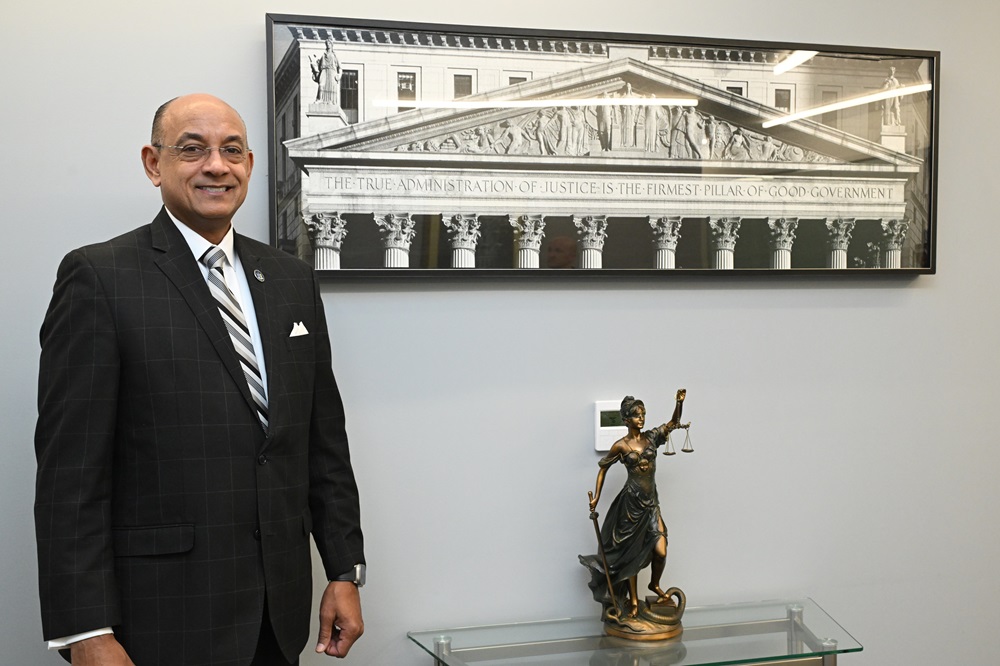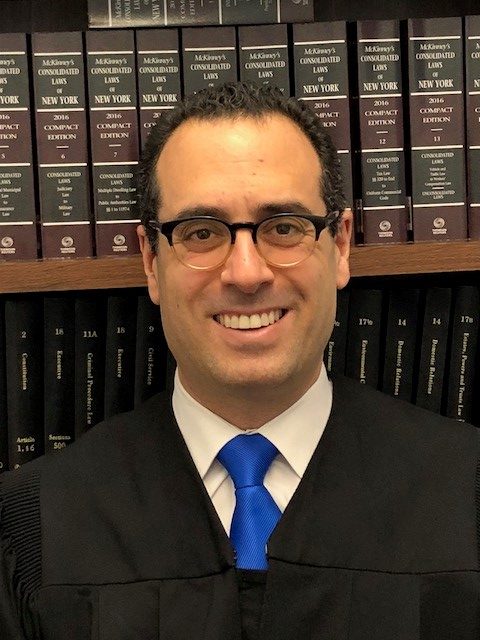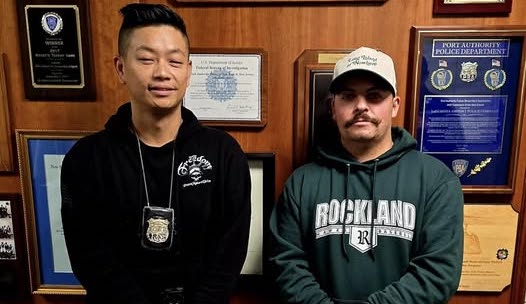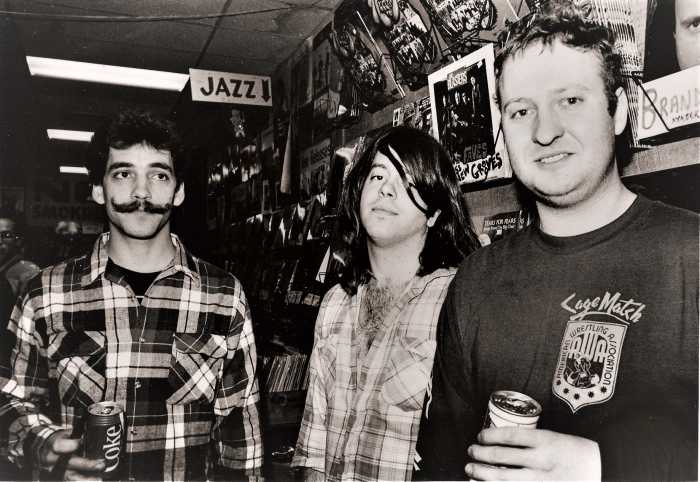Throughout his legal career, Norman St. George has pursued the “cutting edge.” If he was going to be a doctor, he would have performed the most complicated surgery — on the heart, the brain or maybe on the hand because of its intricate movements, he said.
When growing up, his parents gave him an ultimatum to be a doctor or a lawyer. St. George said he chose law after blanching at the sight of blood during a high school vivisection.
In June 2023, he became New York’s First Deputy Chief Administrative Judge, the third in the hierarchy of the administration of the state court system — one that is complicated, and sometimes antiquated — arguably the hand surgery equivalent of state court systems.
As the second administrator in command under Chief Administrative Judge Joseph Zayas, St. George is in charge of overseeing every trial court throughout the state and the $3.7 billion annual operations of the Office of Court Administration.
His trajectory to that position has touched on a remarkable number of parts of the legal profession. He worked as a tax litigator, prosecutor with the Nassau District Attorney’s office, represented celebrities like LL Cool J and Anita Baker at a Wall Street firm and, after joining the bench in 2004, held positions as a trial judge and almost all levels of court administration.
For much of his career, all he wanted to do was compete as a litigator. Now he’s taken his talents for strategizing and organization (St. George printed out a list of topics to share during his interview with amNY Law), and deployed them to meet the challenge of streamlining the state court system and building trust in the judiciary.
The administration’s goal, he said, is the “effective, efficient, appropriate administration of justice.” Why? “Because we need justice to be administered fairly, impartially, professionally, safely, and promptly so that we don’t lose the confidence of the public.”
Tight-Knit Hierarchy
How does one man supervise trial courts across the state’s 62 counties? Hard work and a reliable organizational structure.
Every week, St. George, 61, meets with two deputy chief administrative judges on whom he relies: Deputy Chief Administrative Judge James P. Murphy, who is in charge of all courts outside of New York City and Deputy Chief Administrative Judge Adam Silvera, who is in charge of all New York City courts. St. George remains personally responsible for overseeing the courts on Long Island, where he formerly served as an administrative judge.
He also communicates weekly with Deputy Chief Administrative Judge for Justice Initiatives Edwina G. Richardson, who is an integral part of court leadership. He meets daily with OCA Executive Director Justin Barry.
In addition to St. George, Richardson, Murphy and Silvera there are a network of administrative judges, supervising judges, and statewide coordinating judges who report about the needs of people, technology, and facilities in their judicial districts or courthouses. The structure creates a branching “flow of information” back and forth from the trial courts.
St. George also serves as the third member of the leadership team of Zayas and Chief Judge Rowan Wilson, who have set out to reform the judiciary since Wilson was appointed top judge in 2023. St. George described Wilson as ‘the mind,’ Zayas as the ‘dynamic force’ that brings people together, and himself as the director of organization and operations. He also said Richardson is ‘the heart’.
“We have an exceptional working relationship and engage in true collaboration. It’s an amazing team.”
Wilson’s stated vision for the court system is to bring about comprehensive justice and quality case resolution with a focus on access to justice and equal justice. This includes expanding problem solving courts, alternative dispute resolution, and streamlining court operations. Under the direction of Zayas, St. George is in charge of making sure that Wilson’s and Zayas’s policies, protocols, and initiatives take root throughout the state.
The directive from the chief judge and the chief administrative judge is, “We want to get to ‘yes’,” said St. George, adding that he will not accept roadblocks that start with the explanation of “that’s not how we’ve done things before.”
Retooling New York’s Court Operations
Tuning up a bureaucracy as complex as New York’s court system is no easy task. St. George said that staffing has been a high-order problem.
“When this leadership team came in, there was an archaic method of onboarding new non-judicial personnel,” he said.
Under that system, when any non-judicial staff member would leave their job, the position would be automatically frozen and it took three levels of approval to open it back up. “Then there was a waiting period” until the former employee’s vacation and sick time was recouped. “So now you’re at six months. And now you can interview,” he said.
Under the new system recently instituted, OCA can start hiring for lower-tier positions immediately and for higher-level posts within 30 days.
He said other challenges include confronting the influence of artificial intelligence and the task of adding large numbers of problem-solving courts. For these undertakings, Wilson has paneled an AI advisory group to conduct a deep study and make recommendations, and he continues to rely on Deputy Chief Administrative Judge Edwina Richardson, who is in charge of Office for Justice Initiatives, which oversees all problem-solving courts.
Now a year and a half in the role, St. George can see administrative changes taking shape. For instance, one huge need he identified was a shortage of court officers and court reporters. To remedy the court officer shortage, the number of court officer academy classes was increased from 2 to 4 per year. An expanded academy is also currently under construction to accommodate a greater number of cadets. Regarding court reporters, the number of exams offered was increased, and a trainee program was developed. “Everything’s creative problem solving,” he said.
Within OCA, structural changes have also played out behind the scenes. St. George said that OCA did not have a standalone director of human resources or a director of court modernization, the division in charge of technology in the courtrooms. Those roles were created. A
facilities department in charge of managing court buildings was established. The duties of overseeing contracts, grants and procurements into its own department is being consolidated. Also, the communications department was greatly expanded.

From trial work to administration
St. George’s role was not one that he had envisioned when he graduated from Hofstra Law School or even when he became a judge. For most of his career as an attorney he was a litigator. After a stint as a tax attorney with Arthur Anderson, St. George joined Reisch, Simoni, Bythewood & Gleason in Garden City, then served as a Nassau County Assistant District Attorney before becoming a partner and managing partner in Jackson, Brown, Powell and St. George on Wall Street.
When he became a judge in 2004, something he had always been interested in, it was as a trial judge in Nassau County District Court. He went on to serve as an elected Nassau County Court Judge and Supreme Court Justice.
“Then I was approached to become the supervising judge, and I wasn’t interested in administration. I preferred presiding over trials to organizing schedules.”
He eventually took the position under the misguided pretense that he would have enough time to still try cases (“an absolute farce”). But on his first day in the role, there was an outburst in his arraignment court and an ensuing riot between rival gangs, which injured court officers and ended up with police department intervention. The next week his administrative judge asked, ‘Why was there a riot in your building?’
“At that moment, I realized, ‘Oh, it’s everything,’” he said of court administration. He met with the head of building security, the police department, the sheriff’s department and set up protocols for how an arraignment court should operate. The result changed the configuration of the court so that it would have extra court officers for high-profile cases.
Since then, he moved up the ranks to become the administrative judge of Nassau County and the deputy chief administrative judge for all the courts outside the city. So by the time Wilson and Zayas called on him to join the team, the only administrative role he hadn’t occupied was the deputy chief administrative judge for inside the city.
“I knew the system from the ground up,” St. George said.
It turns out that St. George’s career focus on trial litigation translated well to the skills of an administrative judge. He realized administration boils down to rigorous preparation and forethought. As an administrator, he’s often the one to bring a detailed agenda to meetings.
“If you are a litigator, you need to know beforehand where the other side is coming from. You need to know the strengths of your case or weakness, and the strength or weakness of the opposing counsel and then you prepare for it,” he said. “That’s Sun Tzu, ‘The Art of War, ’ right? Your battle’s won before you step on the battlefield.”
St. George’s inclination to push boundaries extends into his personal life. His hobbies include piloting airplanes, racing cars, scuba diving and sailing.
“You would think that that’s adrenaline,” St. George said about car racing. “But to me it’s a peacefulness.” For him, sailing and flying are about using the guiding principles of physics and “mastering the elements.”
Something similar could be said about the system St. George uses to manage the roughly 300-odd emails that end up in his inbox on a daily basis. It boils down to his reliance on basic organizing principles and an outstanding administrative team. “Don’t move a piece of paper more than once,” he said, referring to a filing system.
Just like in car racing or flying, St. George seems to find satisfaction when stakes are high. “It’s back to my mantra of ‘we are keeping the courts operating and open because it’s a bedrock of our civilization’,” he said.
Read More: https://www.amny.com/law/






































